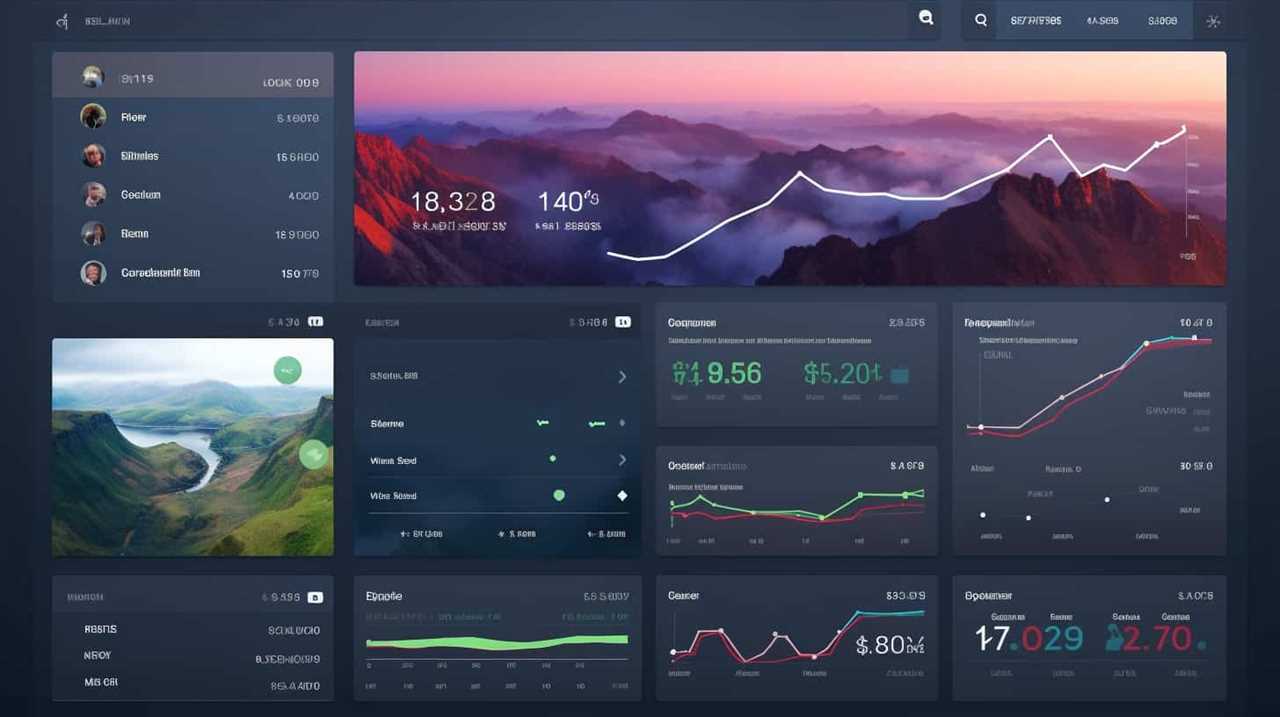Our commitment lies in showcasing how simple and effective SEO can be. Our comprehensive manual will guide you through each detail of optimizing your website for search engines, one step at a time.
From conducting keyword research to building high-quality backlinks, we’ll cover it all. And to make things even better, we’ll provide you with real-life examples that demonstrate the power of SEO.
Get ready to master the art of SEO and take your website to new heights!
Key Takeaways
- Implement SEO ranking factors to improve website visibility and increase organic traffic.
- Conduct keyword research and optimization to target specific keyword phrases with lower competition and higher conversion rates.
- Analyze and optimize on-page elements such as content, meta tags, and URL structure to ensure relevance and improve search engine visibility.
- Implement link building strategies to increase the number of high-quality backlinks and build relationships with relevant website owners.
Understanding SEO Basics
Let’s dive into the basics of SEO and understand how it works.

To achieve a high search engine ranking, it’s important to implement SEO ranking factors and follow SEO best practices.
SEO ranking factors are the elements that search engines consider when determining the relevance and authority of a website. These factors include website speed, mobile-friendliness, quality content, backlinks, and user experience.
By optimizing these factors, you can improve your website’s visibility and increase organic traffic.
SEO best practices involve techniques such as keyword optimization, meta tags, proper URL structure, and internal linking. By implementing these strategies, you can enhance your website’s search engine visibility and attract more targeted visitors.

Now that we’ve a solid understanding of SEO basics, let’s move on to the next step: conducting keyword research.
Conducting Keyword Research
Now that we have a solid understanding of SEO basics, we can delve into the next step of conducting keyword research. Keyword research is a crucial part of any SEO strategy as it helps us identify the words and phrases that people are using to search for information related to our website or business. One effective way to conduct keyword research is through competitor analysis. By analyzing the keywords that our competitors are targeting, we can gain insights into what is working in our industry and identify opportunities that we may have missed. Another important aspect of keyword research is identifying long tail keywords. These are longer and more specific keyword phrases that have less competition but can still drive targeted traffic to our website. By incorporating competitor analysis and long tail keywords into our keyword research process, we can optimize our website for maximum visibility and attract the right audience.
| Competitor Analysis | Long Tail Keywords |
|---|---|
| Identify competitors | Identify specific keyword phrases |
| Analyze their keyword rankings | Lower competition and higher conversion rates |
| Identify opportunities and gaps | Targeted traffic |
| Understand industry trends | Improve organic search visibility |
| Optimize website for maximum visibility | Target niche audience |
Optimizing On-Page Elements
To optimize on-page elements, we start by analyzing and optimizing the content, meta tags, and URL structure of our website. Here are four on-page optimization techniques to improve our SEO content strategy:
- Content Optimization: Ensure our content is relevant, informative, and well-structured. Use relevant keywords naturally and include headers, bullet points, and images to enhance readability.
- Meta Tag Optimization: Craft compelling meta titles and descriptions that accurately represent the page’s content and entice users to click. Include relevant keywords to improve search engine visibility.
- URL Structure Optimization: Create clean and descriptive URLs that include relevant keywords. Avoid lengthy URLs and use hyphens to separate words for better readability.
- Internal Linking: Link relevant pages within our website to improve navigation and spread link equity. Use descriptive anchor text that includes relevant keywords.
By optimizing these on-page elements, we can enhance our website’s visibility and user experience.

Now let’s explore building high-quality backlinks to further improve our SEO strategy.
Building High-Quality Backlinks
When it comes to building high-quality backlinks, there are two key points to consider: link outreach strategies and link building techniques.
Link outreach strategies involve reaching out to other websites or individuals to request a backlink.
On the other hand, link building techniques refer to the methods used to acquire those backlinks.

By implementing effective link outreach strategies and utilizing proven link building techniques, we can increase the number of high-quality backlinks pointing to our website.
Ultimately, this will improve our SEO efforts.
Link Outreach Strategies
We actively engage in link outreach strategies to build high-quality backlinks. Here are four effective techniques we use to enhance our link building efforts:
- Link Prospecting: We conduct thorough research to identify websites in our niche that have the potential to provide valuable backlinks. This involves analyzing their relevance, authority, and trustworthiness.
- Outreach Email Templates: We create personalized email templates that stand out and grab the attention of website owners. These templates include compelling subject lines, personalized introductions, and clear requests for backlinks.
- Building Relationships: We understand the importance of building genuine relationships with website owners. By engaging in meaningful conversations, offering value, and showing appreciation for their content, we increase the likelihood of them linking to our website.
- Guest Posting Opportunities: We actively seek out guest posting opportunities on authoritative websites in our industry. This allows us to showcase our expertise, provide valuable content, and earn high-quality backlinks.
With these strategies, we maximize our chances of acquiring high-quality backlinks and improving our website’s SEO performance.

Now, let’s dive into the next section about link building techniques.
Link Building Techniques
Continuing with our link building efforts, we employ various techniques to ensure the acquisition of high-quality backlinks. One of the most effective outreach strategies we use is reaching out to relevant websites and influencers in our industry. By establishing genuine relationships and offering valuable content, we increase the chances of them linking to our website naturally.
Another technique we employ is guest blogging on authoritative websites. This allows us to not only showcase our expertise but also earn backlinks from reputable sources.
Additionally, we actively participate in online communities and forums, where we contribute valuable insights and provide helpful information. This helps us build relationships with other industry professionals and earn backlinks organically.

These techniques, when done correctly, contribute to natural link building and enhance our website’s authority and visibility in search engine rankings.
Now, let’s move on to the next section about creating engaging and SEO-friendly content.
Creating Engaging and SEO-Friendly Content
To optimize your website for search engines, it’s essential to create engaging and SEO-friendly content. Here are four tips to help you achieve this:
- Create shareable content: Craft content that’s valuable and interesting to your target audience. Make it easy for them to share your content on social media platforms, increasing your reach and visibility.
- Improve user experience: Ensure that your website is user-friendly and easy to navigate. Use clear headings, bullet points, and subheadings to organize your content. Optimize page loading speed and make sure your website is mobile-friendly.
- Use relevant keywords: Conduct keyword research to identify the terms and phrases your audience is searching for. Incorporate these keywords naturally throughout your content to improve its visibility in search engine results.
- Write compelling headlines: Grab your readers’ attention with catchy and informative headlines. Make sure your headlines accurately reflect the content of your page to improve click-through rates.
Utilizing Technical SEO Techniques
When it comes to utilizing technical SEO techniques, there are three key points to focus on:

- Crawlability and indexing: Ensuring that search engine bots can easily crawl and index your website is crucial for visibility.
- Page speed optimization: Optimizing your page speed helps improve user experience and can positively impact your search engine rankings.
- Structured data implementation: Implementing structured data helps search engines understand the content on your website better, leading to enhanced visibility in search results.
Crawlability and Indexing
Our goal is to ensure that every page on our website is easily accessible and indexed by search engines. To achieve this, we need to focus on crawlability and indexing.
Here are four key techniques to consider:
- Optimizing website architecture: A well-organized and logical website structure helps search engines navigate and understand your content better. Use clear and descriptive URLs, create a hierarchical structure, and interlink related pages.
- Creating an XML sitemap: An XML sitemap provides search engines with a roadmap of your website’s pages. By submitting it to search engines, you can ensure that all your important pages are discovered and indexed efficiently.
- Fixing crawl errors: Regularly monitor your website for crawl errors, such as broken links or inaccessible pages. Fixing these issues promptly helps search engines crawl and index your site more effectively.
- Implementing structured data: Adding structured data markup to your website helps search engines understand your content in a more meaningful way. This can enhance your search engine visibility and increase the chances of appearing in rich snippets.
Page Speed Optimization
We can greatly enhance website performance by optimizing page speed through technical SEO techniques.
One important aspect of page speed optimization is mobile optimization. With the increasing number of users accessing websites on mobile devices, it’s crucial to ensure that your website is optimized for mobile viewing. This includes minimizing the use of large images and using responsive design to ensure that your website adapts to different screen sizes.

Another key factor in page speed optimization is image optimization. Large image files can significantly slow down page load times. By compressing images and using the appropriate file formats, you can reduce the file size without compromising image quality.
Additionally, implementing lazy loading techniques can further improve page load times by loading images only when they’re in the user’s view.
Structured Data Implementation
To continue optimizing our website’s page speed, we can implement structured data using technical SEO techniques. Structured data markup, also known as schema.org implementation, helps search engines understand the content on our website and display it in a more meaningful way to users.
Here are four reasons why structured data implementation is important:

- Enhanced search results: By marking up our content with structured data, we can provide search engines with valuable information about our website, such as product details, reviews, and ratings. This can lead to rich snippets in search results, increasing visibility and click-through rates.
- Improved user experience: Structured data helps search engines display relevant information directly in search results, making it easier for users to find what they’re looking for without even visiting our website.
- Increased visibility on voice search: With the rise of voice assistants like Siri and Alexa, structured data becomes even more crucial. By implementing schema.org markup, we can optimize our website to appear in voice search results, capturing a larger audience.
- Future-proofing our website: As search engines continue to evolve, structured data is becoming an essential aspect of SEO. By staying ahead of the curve and implementing schema.org markup, we can ensure our website remains relevant and visible in the ever-changing digital landscape.
Implementing structured data using technical SEO techniques is a powerful way to optimize our website for improved search visibility, user experience, and future-proofing.
Monitoring and Analyzing SEO Performance
Effective monitoring and analysis of SEO performance is crucial for optimizing website rankings and driving organic traffic. To track and measure SEO success, it is essential to use reliable tools and metrics. Here is a table that highlights four key metrics for monitoring and analyzing SEO performance:
| Metric | Description |
|---|---|
| Organic Traffic | The number of visitors that come to your website through search engines. |
| Keyword Rankings | The position of your website in search engine results for targeted keywords. |
| Click-Through Rate (CTR) | The percentage of users who click on your website’s link in search results. |
| Bounce Rate | The percentage of visitors who leave your website after viewing only one page. |
Frequently Asked Questions
How Long Does It Typically Take to See Results From SEO Efforts?
Typically, it takes time to see results from SEO efforts. The SEO results timeline can vary depending on various factors. It’s important to measure SEO success regularly to track progress and make necessary adjustments.
What Are the Most Common SEO Mistakes That Should Be Avoided?
When it comes to SEO, there are common mistakes that should be avoided. By understanding these mistakes and implementing effective SEO strategies, we can ensure better results for our website.

Can SEO Be Done Effectively Without Hiring an SEO Agency?
Yes, we can definitely achieve SEO effectiveness without hiring an SEO agency. With the right knowledge and tools, we can confidently tackle DIY SEO and optimize our website for improved rankings and visibility.
Is It Necessary to Constantly Update and Modify SEO Strategies Over Time?
Yes, it is necessary to constantly update and modify SEO strategies over time. The importance of keyword research in SEO and the role of user experience in SEO success make staying current crucial for achieving optimal results.
How Does Mobile Optimization Impact SEO Rankings?
Mobile optimization, specifically mobile first indexing, is crucial for SEO rankings. It impacts rankings by considering the responsiveness and speed of a website on mobile devices. Page load speed is a significant factor in determining SEO rankings.
Conclusion
In conclusion, mastering SEO is essential for improving website visibility and driving organic traffic. By understanding the basics, conducting thorough keyword research, optimizing on-page elements, building high-quality backlinks, and creating engaging content, one can achieve great results.

Additionally, utilizing technical SEO techniques is crucial for ensuring that search engines can crawl and index your website effectively. This includes optimizing site speed, implementing schema markup, and improving mobile-friendliness.
Furthermore, monitoring and analyzing SEO performance is necessary for making necessary adjustments and improvements. This involves tracking keyword rankings, monitoring website traffic and engagement metrics, and identifying areas for optimization.
With dedication and strategic implementation, anyone can succeed in enhancing their website’s search engine rankings and attracting more visitors.









